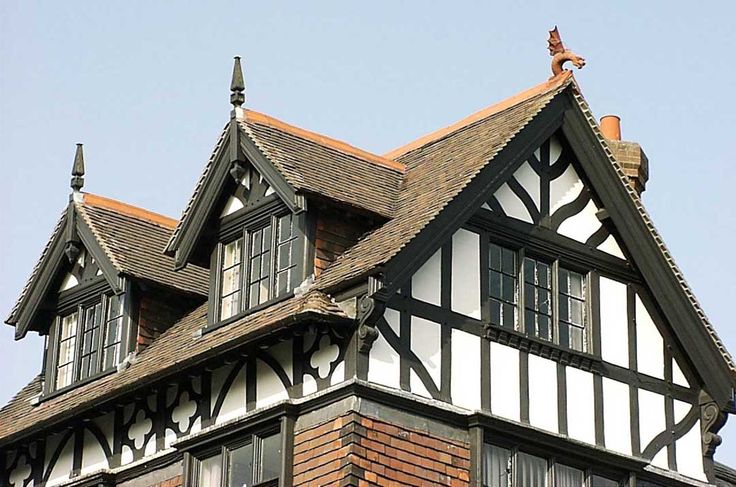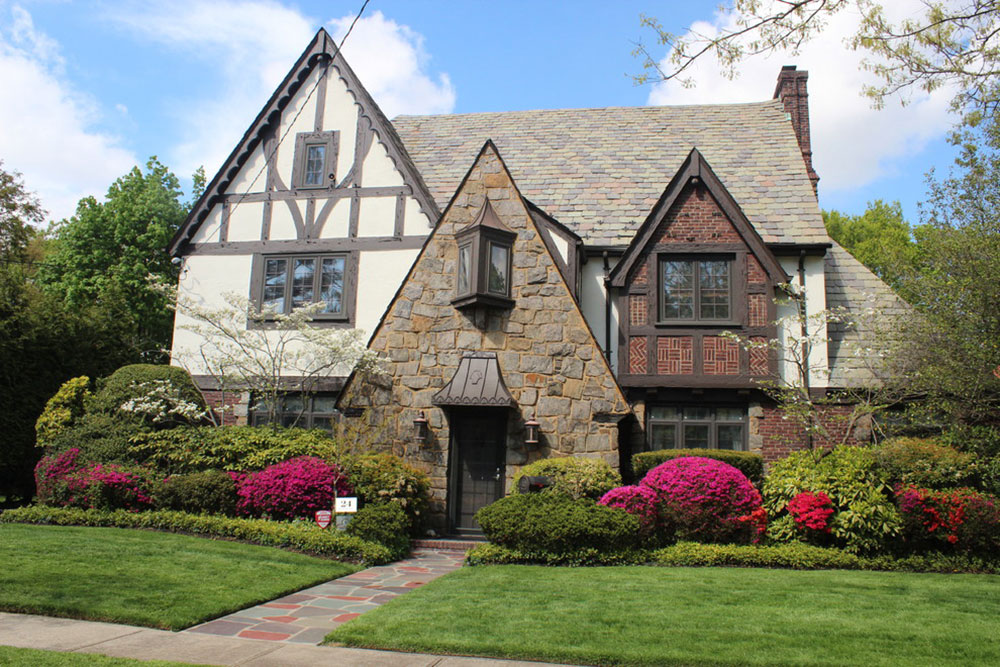Tudor architecture is a style that has been used in the construction of homes and other buildings in the United States since 1890. Despite its popularity during this period, there are many who do not know what Tudor architecture is.
This guide will help you understand and learn about Tudor Architecture so that you can easily identify houses built during the period 1890-1940.
Definition of Tudor Architecture
If you’re like most people, you probably have seen a house with features such as half-timbering, steep roofs, tall narrow doors. You may also have seen long casement windows arranged vertically on buildings that resembled castles or cathedrals of Medieval Europe.

Image credit: https://www.seniorlifestyle.com/
You might even be able to identify these features as being part of an overall “Tudor” look but may not immediately recognize them as belonging to one specific architectural style known as Tudor Style Architecture. Tudor refers to a period between 1890 and 1940 when European trained architects came to America and brought their unique styles, making each building distinctly different.
Built for wealthy homeowners, Tudor houses were built of solid masonry with elaborate decorative stone and brickwork. They were also called Stockbroker Tudor because they were built for people who had made their money on Wall Street.
A notable feature that distinguishes them from other kinds of homes is their steeply pitched, front-facing gables usually decorated with intricate carvings. However, the most distinctive feature and most commonly associated with this style is the “half-timbering,” which is the decorative imitation of structural timbers.
The Fall of Tudor Homes
This transitional style continued to pop up in villages throughout England until Elizabethan architecture took over in 1558. While it became so popular during the Tudor Dynasty, it fell out of favor when Elizabeth I came to power. This style lasted until the early 16th century, also coinciding with Henry VII and Henry VIII, who hailed from the house of Tudor.
However, Tudor Revival Architecture is less common than other American architecture styles, but its unmistakable charm makes it a fan favorite. Tudor Revival homes are located in the northern U.S because their facade is ideal for colder climates. These Tudor revival homes are also called mock Tudor.
Tudor style was also out of popularity around World War II when the resurgence of patriotism encouraged an appreciation of more American style, which is colonial revival. Tudor revival architecture was also expensive to build in the past, so it was more common among wealthy people.
Famous Tudor examples include a Tudor house in Montgomery, which is the landmark Newlands Memorial Mansion. These types of homes are commonly found in the northern United States. The residence has a variety of features, making highly stylized Tudor, including dormers, richly decorative chimney pots, uncoursed stone, half-timbering wide, decorative verge boards, and a stone porte-cochere.
Characteristics of Tudor Houses
Tudor homes are characterized by their steeply pitched gable roofs which are cross-shaped. Other features include the use of stone, brick, or half-timber, small windows with multiple panes, and masonry chimney pots.

Image credit: https://simplynorthshore.com/
This stockbroker often featured brick and stone walls on the first story and upper floors were stud-framed and covered with stucco walls and decorative faux timbers.
Materials
American Tudors are easily recognized by their characteristic steep, cross-shaped gable roofs and stucco walls. Decorative brackets and beams support the large overhang of the roof. The facade may be brick or stone, while the other walls are generally finished in stucco, half timber, or wood shingle siding.
Sometimes a large porch covers the front door and extends across the front of the house parallel to the street. A small cottage-style porch may also adorn a side entrance, often under a separate roof extending over a breeze-way or breezeway.
Roof
A distinguishing feature of Tudor house was the steep gabled roof. The steep pitch of the roof was intended to funnel rainwater off as quickly as possible. In several instances, the roofs have been built with a slight curve from front to back to direct more rainfall into the center of the building and then outside.

Image credit: https://i.pinimg.com/
Cotswold stone slabs replaced the traditional thatched roof. The roofs on the later buildings were of slate and occasionally of tile, but some houses still have thatched roofs today.
Windows
Tudor-styles houses had casement windows grouped in rows of three or more, each opening from a single sash. Double-hung windows were not that common. Windows were divided into six or eight rectangular panes and arranged in a diamond pattern, with the latter style often executed in leaded glass.
Windows were usually placed symmetrically on either side of the doorways. Panes were commonly diamond-shaped, with several panes grouped or separated by stone mullions. Rows of diamond-pane windows are often found on the first floor above the ground floor, sometimes in three large windows capped with ogee arches.
Entrance
The Tudor entrance was part of asymmetrical architectural elements, some for decorative and some for protection. A small entry porch is sometimes incorporated into or at least approaches the main entrance to protect from inclement weather. This is frequently achieved by a direct but unobtrusive entry which consists of two or three steps leading up to an enclosed vestibule.

Image credit: https://www.impressiveinteriordesign.com/
Designed for pure comfort, the parlor is often located on the first floor just off the main entrance and is usually furnished with a sofa and chairs. Builders also accented the interior spaces with dark wood detailing on the floors, walls and ceilings.
How to Recognize a Tudor Revival House
Traditional Tudor houses are usually large and located in oversized lots. You can easily recognize them by features such as rectangular windows, half-timbered exterior facades together with stucco or decorative brickwork. You’ll also see chunky iron door ware for medieval architecture, earth-tone cladding colors, and multi paned windows or diamond-shaped where some are leaded glass.
Tudor Style Homes Today
Smaller Tudor homes are also being built today. Architects have taken the traditional Tudor design and modified it into a smaller, more affordable version that can be used in areas where space is limited. So, if you’re building your own house Tudor style, you’ll definitely like the modern design.
These homes are still recognized for their half-timbered exterior facades, which are made with masonry materials.
Their roofs are steeply pitched to give the homes lots of character but may have tiles, slates, or shingles instead of the traditional thatching. The windows on Tudor homes are tall and narrow, but they can come in multiple panes. Sometimes five to six panes provide better insulation for living in colder climates that are more typically found in Europe, where the design was originally developed.
Problems Associated with Modern Tudor Styles
Even if Tudor houses have been restored to an aesthetic look, their unique look and design will present maintenance and upkeep issues because of compelling elements such as slate roofs, plaster walls, and highly inefficient leaded glass windows.
FAQs on What is Tudor Architecture
Who created Tudor architecture?
Tudor revival was started with a designer called William Morris and architect Richard Norman Shaw in England in the 16th century.
What is an example of Tudor architecture?
The Adams Building, located in Quincy, Massachusetts, is one of the best-known examples of Tudor design. The other good examples are Hampton Court and Hardwick Hall.
Final Thought on What is Tudor Architecture
That’s all about Tudor Architecture. It’s all about the historic elements creating a unique style. In England, this final evolution of medieval architecture is available in many communities in Europe, America, Canada, and Britain.
The post What Is Tudor Architecture? appeared first on Kitchen Infinity.
Did you miss our previous article…
https://chefbuano.com/?p=573